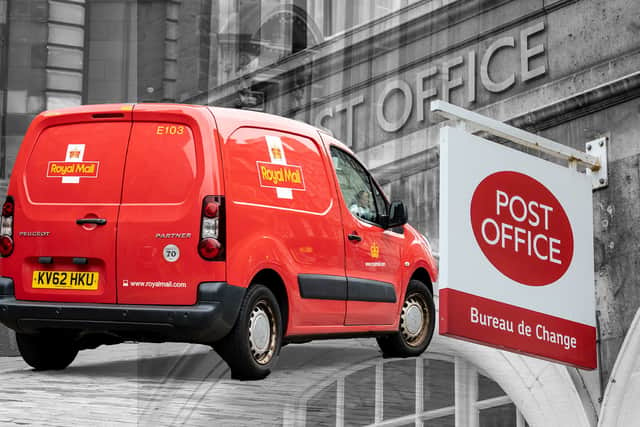Royal Mail vs Post Office: are they the same, what’s the difference, who’s been on strike - services explained
and live on Freeview channel 276
Royal Mail staged numerous strikes last year, including six days in December, costing the company more than £100 million and causing huge delays to Christmas cards and parcel deliveries.
Further disruption could be coming soon as Royal Mail workers and bosses both remain locked in a pay dispute.
Advertisement
Hide AdAdvertisement
Hide AdThe Communication Workers Union (CWU) has rejected Royal Mail management’s “best and final” offer of a pay rise of up to 9% over 18 months in exchange for changes to working hours and voluntary Sunday working. The result of the ballot papers will be due on 16 February.
Meanwhile Post Office workers, who also staged walkouts last year, could also join Royal Mail staff who are striking this year. A union chief said his members were “willing to take further action” amid an ongoing pay dispute.
But what is the difference between Royal Mail and the Post Office, who has been on strike, and how do their services differ?


What services do Royal Mail and the Post Office offer?
Royal Mail and the Post Office are separate companies with independent boards.
Advertisement
Hide AdAdvertisement
Hide AdRoyal Mail is the company that delivers parcels and letters from post offices. It deals mainly with the delivery and collection of items. Royal Mail doesn’t usually sell stamps themselves or offer many stamping services, apart from selling some stamps online.
The Post Office deals with stamping and preparing parcels for shipping, and offers other services like banking and money withdrawals.
It is the nationwide network of branches offering a range of postal, government and financial services. For example, if you want to use Royal Mail’s guaranteed next-day delivery or signature-on-delivery services, you will need to visit your local post office.
Who owns Royal Mail?
Royal Mail is a public limited company, meaning it is owned by its shareholders. For most of its life Royal Mail was owned by the UK government and remained a public service until the 2010s.
Advertisement
Hide AdAdvertisement
Hide AdThe Postal Services Act 2011 allowed the Conservative and Liberal Democrat coalition government to sell off shares in Royal Mail to private investors. These shares were floated on the London Stock Exchange in 2013.
The Government initially retained a 30% stake in Royal Mail, but sold its remaining shares in 2015 Royal Mail’s privatisation was controversial, and it led to widespread strikes called by the CWU.
Who owns the Post Office?
The Post Office is a separate company owned by the government.
The Department for Business, Innovation and Skills, which is responsible for the Post Office, explained on its website: “Royal Mail and the Post Office are separate companies with independent boards. Royal Mail is the company that delivers parcels and letters – the provider of the universal postal service.
Advertisement
Hide AdAdvertisement
Hide Ad“The Post Office is the nationwide network of branches offering a range of postal, government and financial services. The Post Office is not for sale.”
Who has been on strike?
Royal Mail went on strike over numerous days last year where letters and parcels were not delivered and their services were hugely disrupted.
Dave Ward, CWU general secretary, said: “Nobody takes the decision to strike lightly, but postal workers are being pushed to the brink. There can be no doubt that postal workers are completely united in their determination to secure the dignified, proper pay rise they deserve.”
He added that people “can’t keep on living in a country where bosses rake in billions in profit while their employees are forced to use food banks. The CWU’s message to Royal Mail’s leadership is simple – there will be serious disruption until you get real on pay.”
Advertisement
Hide AdAdvertisement
Hide AdRicky McAulay, operations director at Royal Mail, accused the union of failing to engage in “any meaningful discussion” after months of talks.
The majority of Post Offices remained open, because Royal Mail and the Post Office are separate companies.
However, there was separate strike action taking place at Post Offices during December.
On 12 and 13 December Crowns & Admin staged a walkout, while Supply Chain members commenced a two-week ban on overtime. This strike saw around 1,400 staff members walk out.
Advertisement
Hide AdAdvertisement
Hide AdIndustrial action was also announced by the Post Office on 24 and 28 December.
Andy Furey, CWU assistant secretary, which represents around 3,500 Post Office workers, said of the Post Office strikes: "Everybody knows there’s more than enough money for a reasonable pay rise and it’s time for those at the top of the Post Office to show real respect for dedicated public servants who, as key workers, provided unprecedented customer service during the pandemic."
He told the House of Commons business committee that workers had rejected an offer of a five per cent pay rise and that two ballots for strike action had received yes votes of “over 90 per cent.” He said: “We’re... willing to take further action.”
Comment Guidelines
National World encourages reader discussion on our stories. User feedback, insights and back-and-forth exchanges add a rich layer of context to reporting. Please review our Community Guidelines before commenting.
